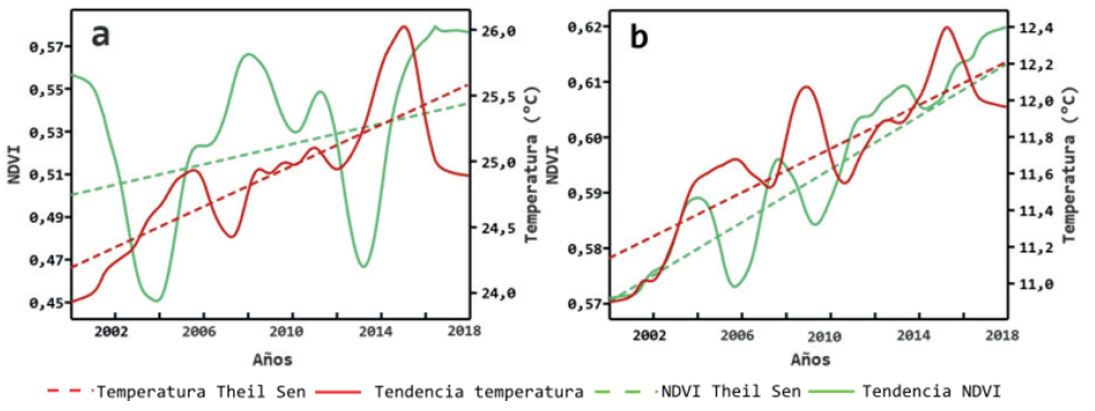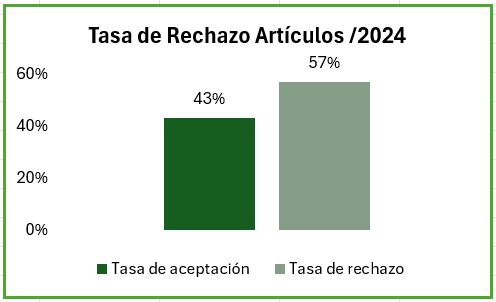Trend analysis of the Normalized Difference Vegetation Index and climatic variables in the ecosystems of the province of Loja, Ecuador
DOI:
https://doi.org/10.54753/blc.v15i1.2367Keywords:
trend, Mann-Kendall, Tau-Kendall, Theil Sen, ecosystemsAbstract
On a global scale, climate change is a threat that influences the functioning of ecosystems. In the southern region of Ecuador, the effects of local and regional climate variability on its ecosystems are unknown. The objective of this research was to analyze the trends of the normalized difference vegetation index (NDVI) in relation to the trends of temperature and precipitation in the period 2001-2018 in the lowland deciduous forest ecosystem of Jama Zapotillo (BdTc01) and Paramo grassland (HsSn02). To achieve this purpose, the Loess trend of the time series of the climatic variables of the study was obtained, the Mann Kendall test determined the presence of trend, as a complement the Tau Kendall coefficient defined positive values for upward trends. Finally, the Theil Sen test calculated the increase or decrease of the variable per unit of time. The results indicate in the period 2001-2018 the temperature increased by 1,4 °C in BdTc01 and 1,08 °C in HsSn02. While precipitation increased by 17,26 mm in BdTc01 and 23,75 mm in HsSn02. However, NDVI was similar showing a 0,04 increase in both study ecosystems. The research concludes that, in the period 2001-2018, the temperature increases in the lowland deciduous forest ecosystem of Jama Zapotillo and Herbazal del Páramo constitutes a threat whose magnitude is amplified by regional climate anomalies that influence the local climate.References
Almar, R., Boucharel, J., Graffin, M., Abessolo, G. O., Thoumyre, G., Papa, F., Ranasinghe, R., Montano, J., Bergsma, E. W. J., Baba, M. W., & Jin, F. (2023). Influence of El Niño on the variability of global shoreline position. Nature Communications, 14(1). https://doi.org/10.1038/s41467-023-38742-9
Brun, P., Zimmermann, N. E., Hari, C., Pellissier, L., & Karger, D. N. (2022). Global climate-related predictors at kilometer resolution for the past and future. Earth System Science Data, 14(12), 5573-5603. https://doi.org/10.5194/essd-14-5573-2022
Calvin, K., Dasgupta, D., Krinner, G., Mukherji, A., Thorne, P. W., Trisos, C., Romero, J., Aldunce, P., Barrett, K., Blanco, G., Cheung, W. W., Connors, S., Denton, F., Diongue-Niang, A., Dodman, D., Garschagen, M., Geden, O., Hayward, B., Jones, C., . . . Ha, M. (2023). IPCC, 2023: Climate Change 2023: Synthesis Report. Contribution of Working Groups I, II and III to the Sixth Assessment Report of the Intergovernmental Panel on Climate Change [Core Writing Team, H. Lee and J. Romero (eds.)]. IPCC, Geneva, Switzerland. https://doi.org/10.59327/ipcc/ar6-9789291691647
Cambindo Altafuya, Ketty Alicia. Deforestación, cambio de uso del suelo y almacenamiento de carbono en el Parque Nacional Cotacachi Cayapas. Quito, 2024, 119 p. Tesis (Maestría en Cambio Climático, Sustentabilidad y Desarrollo). Universidad Andina Simón Bolívar, Sede Ecuador. Área de Ambiente y Sustentabilidad.
Cardinale, B. J., Matulich, K. L., Hooper, D. U., Byrnes, J. E., Duffy, E., Gamfeldt, L., Balvanera, P., O’Connor, M. I., & Gonzalez, A. (2011). The functional role of producer diversity in ecosystems. American Journal Of Botany, 98(3), 572-592. https://doi.org/10.3732/ajb.1000364
Cazalis, V., Princé, K., Mihoub, J., Kelly, J., Butchart, S. H. M., & Rodrigues, A. S. (2020). Effectiveness of protected areas in conserving tropical forest birds. Nature Communications, 11(1). https://doi.org/10.1038/s41467-020-18230-0
Dainese, M., Martin, E. A., Aizen, M. A., Albrecht, M., Bartomeus, I., Bommarco, R., Carvalheiro, L. G., Chaplin-Kramer, R., Gagic, V., Garibaldi, L. A., Ghazoul, J., Grab, H., Jonsson, M., Karp, D. S., Kennedy, C. M., Kleijn, D., Kremen, C., Landis, D. A., Letourneau, D. K., . . . Steffan-Dewenter, I. (2019). A global synthesis reveals biodiversity-mediated benefits for crop production. Science Advances, 5(10). https://doi.org/10.1126/sciadv.aax0121
Didan, K. (2021). MODIS/Terra Vegetation Indices 16-Day L3 Global 500m SIN Grid V061 [Data set]. NASA EOSDIS Land Processes DAAC. Accessed 2023-03-20 from https://doi.org/10.5067/MODIS/MOD13A1.061
Durán, S. M., Martin, R. E., Díaz, S., Maitner, B. S., Malhi, Y., Salinas, N., Shenkin, A., Silman, M. R., Wieczynski, D. J., Asner, G. P., Bentley, L. P., Savage, V. M., & Enquist, B. J. (2019). Informing trait-based ecology by assessing remotely sensed functional diversity across a broad tropical temperature gradient. Science Advances, 5(12). https://doi.org/10.1126/sciadv.aaw8114
Eklundh, L., Jönsson, P. (2015). TIMESAT: A Software Package for Time-Series Processing and Assessment of Vegetation Dynamics. In: Kuenzer, C., Dech, S., Wagner, W. (eds) Remote Sensing Time Series. Remote Sensing and Digital Image Processing, vol 22. Springer, Cham. https://doi.org/10.1007/978-3-319-15967-6_7
Fernando, W. D. (2012). Plants: An International Scientific Open Access Journal to Publish All Facets of Plants, Their Functions and Interactions with the Environment and Other Living Organisms. Plants, 1(1), 1-5. https://doi.org/10.3390/plants1010001
Ferrer-Sánchez, Y., Castillo, A. J. R., Plasencia-Vázquez, A. H., & Abasolo-Pacheco, F. (2024). Impacto del uso de suelo y la fragmentación del paisaje sobre la calidad del agua del río Teaone en Ecuador. Revista Internacional de Contaminación Ambiental, 40, 15-36. https://doi.org/10.20937/rica.54900
García, R., González, A., & Benavidez-Silva, C. (2023). Análisis espacio temporal del Índice de Vegetación de Diferencia Normalizado (NDVI) en el ecosistema bosque semideciduo piemontano del Catamayo Alamor. CEDAMAZ, 13(2), 140-147. https://doi.org/10.54753/cedamaz.v13i2.2053
Haines-Young, R., & Potschin, M. (2010). The links between biodiversity, ecosystem services and human well-being. Ecosystem Ecology: a new synthesis, 1, 110-139.
Hausmann, A., Slotow, R., Burns, J. K., & Di Minin, E. (2015). The ecosystem service of sense of place: benefits for human well-being and biodiversity conservation. Environmental Conservation, 43(2), 117-127. https://doi.org/10.1017/s0376892915000314
IPCC, 2023: Summary for Policymakers. In: Climate Change 2023: Synthesis Report. Contribution of Working Groups I, II and III to the Sixth Assessment Report of the Intergovernmental Panel on Climate Change [Core Writing Team, H. Lee and J. Romero (eds.)]. IPCC, Geneva, Switzerland, pp. 1-34, doi: 10.59327/IPCC/AR6-9789291691647.001
Calvin, K., Dasgupta, D., Krinner, G., Mukherji, A., Thorne, P. W., Trisos, C., Romero, J., Aldunce, P., Barrett, K., Blanco, G., Cheung, W. W., Connors, S., Denton, F., Diongue-Niang, A., Dodman, D., Garschagen, M., Geden, O., Hayward, B., Jones, C., . . . Ha, M. (2023). IPCC, 2023: Climate Change 2023: Synthesis Report. Contribution of Working Groups I, II and III to the Sixth Assessment Report of the Intergovernmental Panel on Climate Change [Core Writing Team, H. Lee and J. Romero (eds.)]. IPCC, Geneva, Switzerland. https://doi.org/10.59327/ipcc/ar6-9789291691647
Feron, S., Cordero, R. R., Damiani, A., MacDonell, S., Pizarro, J., Goubanova, K., Valenzuela, R., Wang, C., Rester, L., & Beaulieu, A. (2024). South America is becoming warmer, drier, and more flammable. Communications Earth & Environment, 5(1). https://doi.org/10.1038/s43247-024-01654-7
Forzieri, G., Dakos, V., Mcdowell, N. G., Ramdane, A., & Cescatti, A. (2022). Emerging signals of declining forest resilience under climate change. Nature, 608(7923), 534-539. https://doi.org/10.1038/s41586-022-04959-9
Higgins, S. I., Conradi, T., & Muhoko, E. (2023). Shifts in vegetation activity of terrestrial ecosystems attributable to climate trends. Nature Geoscience, 16(2), 147-153. https://doi.org/10.1038/s41561-022-01114-x
Karger, D. N., Schmatz, D. R., Dettling, G., & Zimmermann, N. E. (2020). High-resolution monthly precipitation and temperature time series from 2006 to 2100. Scientific Data, 7(1). https://doi.org/10.1038/s41597-020-00587-y
Karger, D. N., Wilson, A. M., Mahony, C., Zimmermann, N. E., & Jetz, W. (2021). Global daily 1 km land surface precipitation based on cloud cover-informed downscaling. Scientific Data, 8(1). https://doi.org/10.1038/s41597-021-01084-6
Kleemann, J., Zamora, C., Villacis-Chiluisa, A. B., Cuenca, P., Koo, H., Noh, J. K., Fürst, C., & Thiel, M. (2022). Deforestation in Continental Ecuador with a Focus on Protected Areas. Land, 11(2), 268. https://doi.org/10.3390/land11020268
Lausch, A., Selsam, P., Pause, M., & Bumberger, J. (2024). Monitoring vegetation- and geodiversity with remote sensing and traits. Philosophical Transactions Of The Royal Society A Mathematical Physical And Engineering Sciences, 382(2269). https://doi.org/10.1098/rsta.2023.0058
Li, J., & Prentice, I. C. (2024). Global patterns of plant functional traits and their relationships to climate. Communications Biology, 7(1). https://doi.org/10.1038/s42003-024-06777-3
Maita, J. (2015). Dinámica espacio temporal del Índice de vegetación Mejorado (EVI) en los Ecosistemas del Sur del Ecuador [Tesis de Maestría, Universidad del Azuay]. Dspace de la Universidad del Azuay. http://dspace.uazuay.edu.ec/handle/datos/4933
Ministerio del Ambiente del Ecuador. (2013). Sistema de Clasificación de Ecosistemas del Ecuador Continental. Subsecretaría de Patrimonio Natural, Quito.
Migliavacca, M., Musavi, T., Mahecha, M. D., Nelson, J. A., Knauer, J., Baldocchi, D. D., Perez-Priego, O., Christiansen, R., Peters, J., Anderson, K., Bahn, M., Black, T. A., Blanken, P. D., Bonal, D., Buchmann, N., Caldararu, S., Carrara, A., Carvalhais, N., Cescatti, A., . . . Reichstein, M. (2021). The three major axes of terrestrial ecosystem function. Nature, 598(7881), 468-472. https://doi.org/10.1038/s41586-021-03939-9
National Aeronautics and Space Administration's Earth Science Data Systems (ESDS) Program (https://search.earthdata.nasa.gov/search).
Nath, D., Nath, R., & Chen, W. (2024). Faster dieback of rainforests altering tropical carbon sinks under climate change. Npj Climate And Atmospheric Science, 7(1). https://doi.org/10.1038/s41612-024-00793-0
Pourrut, P. (1983). Los climas del Ecuador: fundamentos explicativos. Quito.
Psistaki, K., Tsantopoulos, G., & Paschalidou, A. K. (2024). An Overview of the Role of Forests in Climate Change Mitigation. Sustainability, 16(14), 6089. https://doi.org/10.3390/su16146089
QGIS Development Team. (2023). QGIS Geographic Information System (Version 3.32) [Software de geoinformación]. Open-Source Geospatial Foundation Project. https://qgis.org
Sangha, K. K., Gordon, I. J., & Costanza, R. (2022). Ecosystem Services and Human Wellbeing-Based Approaches Can Help Transform Our Economies. Frontiers In Ecology And Evolution, 10. https://doi.org/10.3389/fevo.2022.841215
Senf, C. (2022). Seeing the System from Above: The Use and Potential of Remote Sensing for Studying Ecosystem Dynamics. Ecosystems, 25(8), 1719-1737. https://doi.org/10.1007/s10021-022-00777-2
Udivia Zambrano, K.Y. (2020). Análisis de la dinámica espacio temporal del índice de vegetación de diferencia normalizada (ndvi) y su relación con patrones climáticos globales en el páramo ecuatorial entre el año 2001 y 2018 [Tesis de Maestría, Escuela Politécnica Nacional]. Repositorio digital– EPN. http://bibdigital.epn.edu.ec/handle/15000/21251
Villalba, D. J. S., Pazmiño, L. A. M., Del Corral Villarroel, V. H., Garófalo, M. F. M., Machado, D. A. Y., & Ulloa, C. o. P. (2024). Análisis del estado de la vegetación de una microcuenca amazónica mediante el NDVI. caso de estudio Microcuenca del Río Sandalias. Ciencia Latina Revista Científica Multidisciplinar, 8(4), 11003-11015. https://doi.org/10.37811/cl_rcm.v8i5.13236
World Meteorological Organization (2024). Estado del Clima en América Latina y el Caribe 2023. https://library.wmo.int/records/item/68895-el-estado-del-clima-en-america-latina-y-el-caribe-2023?offset=7
Yang, Y., Wang, S., Bai, X., Tan, Q., Li, Q., Wu, L., Tian, S., Hu, Z., Li, C., & Deng, Y. (2019). Factors Affecting Long-Term Trends in Global NDVI. Forests, 10(5), 372. https://doi.org/10.3390/f10050372
Yin, G., He, W., Liu, X., Xia, Y., & Zhang, H. (2024). Wetting or greening? Probing the global trends in Vegetation Condition Index (VCI). International Journal Of Applied Earth Observation And Geoinformation, 129, 103822. https://doi.org/10.1016/j.jag.2024.103822
Zeng, Y., Koh, L. P., & Wilcove, D. S. (2022). Gains in biodiversity conservation and ecosystem services from the expansion of the planet’s protected areas. Science Advances, 8(22). https://doi.org/10.1126/sciadv.abl9885

Published
How to Cite
Issue
Section
License
Copyright (c) 2025 Bosques Latitud Cero

This work is licensed under a Creative Commons Attribution-NonCommercial-ShareAlike 4.0 International License.
This work is published under the Creative Commons Attribution-NonCommercial-ShareAlike 4.0 International (CC BY-NC-SA 4.0) license. This means that users may copy, distribute, and adapt the content, provided that proper credit is given to the authors and the journal. Commercial use of the material is not permitted. Additionally, any derivative work must be distributed under the same license. This license ensures open access to knowledge, promoting the dissemination and reuse of published works for non-commercial purposes, respecting authorship, and ensuring the free circulation of content under fair terms.




























